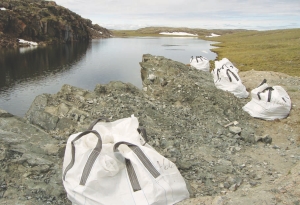A conceptual study suggests that Stornoway Diamond (SWY-T, SWYDF-o) could find 24.1 to 40.3 million carats of diamonds in the Eastern Sheet Complex of its Aviat project, in eastern Nunavut.
The study, done by SRK Consulting, notes that testing to date on the Eastern Sheet Complex (ESC) is insufficient for a National Instrument 43-101 resource estimate, but Stornoway CEO Eira Thomas says the results from a 202- tonne mini-bulk sample, expected in early 2009, will provide more insight into the grade, diamond value and economic potential of the project. In the meantime, Thomas says the figures from the conceptual study put the company on the map in the diamond exploration world.
“There are few deposits around the world right now that are bigger than 10,000 carats in size,” Thomas says. “The combination of grade and tonnage has given us the potential for an economic diamond deposit.”
According to the study, the ESC has a conceptual resource of 235 carats per hundred tonnes (accurate to within 30 carats per hundred tonnes), assuming 100% recovery and based on limited micro and macrodiamond data collected between 2003 and 2007.
The ESC is thought to contain four kimberlite dykes totalling 12.4 to 16 million tonnes of kimberl i te material. One of the dykes, ES 1, spans an area of 2.6 sq. km and represents 78% of the kimberlite volume, while the entire Aviat project covers almost 2,000 sq. km.
The company’s been developing the project, located 50 km from the coast along the Melville Peninsula, since 2002. But it wasn’t until 2006 that, in what Thomas describes as a eureka! moment, Stornoway realized how big the deposit might be.
“We thought we were chasing a bunch of vertical kimberlite dykes,” Thomas explains. “Then one of our geologists postulated that the kimberlites could represent flat sheets.”
This revelation proved correct — Eira says the company went back the following year and consistently and predictably intercepted kimberlite in a major drilling campaign. SRK took all the data and put it into a model and came up with the latest results.
“The study confirmed that the sheets were contiguous and sizable, but also a good grade,” Thomas says.
None of the kimberlites are under major bodies of water and all are high-grade, laterally contiguous and shallowly dipping, with about 80% of the deposit within 100 metres of surface. The deposit also shows significant expansion potential for downdip extensions elsewhere within the ESC, and in other pipe-like bodies that were not included in the SRK study.
Thomas says that if the bulk sample is also positive, Stornoway will have to decide whether the kimberlite sheets would be best mined by open-pit or underground methods.
She says Aviat is shaping up to be a key project for the company. Its top focus though, is the prefeasibility- level Renard diamond project in the Otish Mountains of Quebec, a 50% joint venture with Quebec government-owned Soquem.
Although Renard is more developed — the company expects a new resource calculation in the coming weeks — the deposit was last estimated to hold 17 to 21 million carats, or about half of the blue sky potential of Aviat. Plus, Stornoway has a larger interest in Aviat, controlling 90% of the project and holding 100% of the marketing rights, while Hunter Exploration has a 10% carried interest. “So it’s potentially much larger for Stornoway itself,” Thomas says.
Aviat’s location also has its merits when compared with other diamond projects in the Far North. The project is close to the coast, which is moderated by a fairly warm stream current — meaning that the waters are ice-free for six months of the year and only a light ice-breaking vessel is needed for the remainder.
BHP Billiton’s (BHP-N, BLT-l) Ekati mine and the Diavik diamond mine, owned by Rio Tinto (RTP-N, RIO-l) and Harry Winston Diamond (HW-T, HWD-n),on the other hand, are landlocked and dependent on winter ice roads for supplies. Both mines are located in the Northwest Territories.
“So all around it’s a very accessible part of the Arctic,” Thomas says of Aviat’s location. “It has its challenges climatically, but we’re Canadians and we’re good at mining in the North.”
As for the current financial storm, Stornoway is prepared to weather that too. The company’s share price was 11 at presstime, half a penny above its 52-week low and far from its high of 95.
“Given where our share price is trading, there is no question we are looking to prioritize and focus on our key projects in 2009,” Thomas says.
She says the company isn’t planning to spend a lot of money next year, but won’t have any idea of a budget until the results are in for Renard. At Aviat, Thomas says the company’s land position is secure.
“We aren’t compelled to go in and spend a lot of money in 2009 if we don’t wish to,” Thomas says. “It will all come down to how the market behaves in the next six months, the opportunities for financing and how aggressive we want to be with raising capital in this kind of environment.”


Be the first to comment on "Study puts Stornoway’s Aviat on the diamond map"